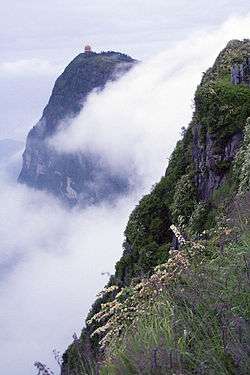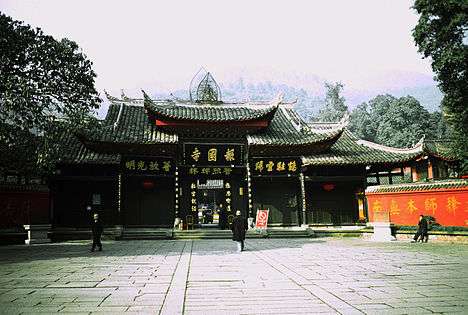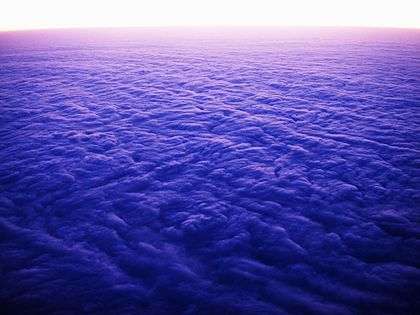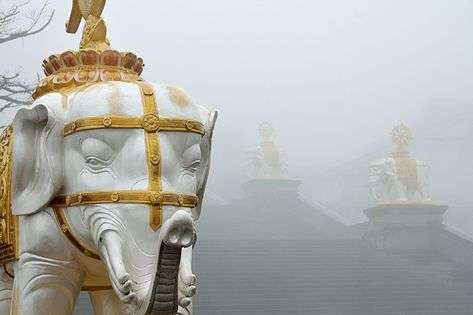Mount Emei
| Mount Emei | |
|---|---|
| Emei Shan | |
 | |
| Highest point | |
| Elevation | 3,099 m (10,167 ft) |
| Coordinates | 29°31′11″N 103°19′57″E / 29.51972°N 103.33250°ECoordinates: 29°31′11″N 103°19′57″E / 29.51972°N 103.33250°E |
| Geography | |
 Mount Emei | |
| Official name | Mount Emei Scenic Area, including Leshan Giant Buddha Scenic Area |
| Type | Mixed |
| Criteria | iv, vi, x |
| Designated | 1996 (20th session) |
| Reference no. | 779 |
| State Party |
|
| Region | Asia-Pacific |
| Mount Emei | |||||||||||||||||||||||||||
|
"Mount Emei" in Chinese characters | |||||||||||||||||||||||||||
| Chinese | 峨眉山[1] | ||||||||||||||||||||||||||
|---|---|---|---|---|---|---|---|---|---|---|---|---|---|---|---|---|---|---|---|---|---|---|---|---|---|---|---|
| |||||||||||||||||||||||||||
| Part of a series on |
| Chinese martial arts (Wushu) |
|---|
 |
|
Styles of Chinese martial arts
|
| Wushu in the world |
|
Historical locations Chen Village (陳家溝) |
| Wushu athletes/practitioners |
|
Legendary figures Bodhidharma (菩提達摩) |
|
Historical individuals Yue Fei (岳飛; 1103—1142) |
|
Modern celebrities Bruce Lee (李小龍 1940—1973) |
| Wushu influence |
|
Related |
Mount Emei ([ɤ̌.měi̯]; Chinese: 峨眉山[1]; pinyin: Éméi shān) is a mountain in Sichuan Province, China, and is one of the Four Sacred Buddhist Mountains of China. Mt. Emei sits at the western rim of the Sichuan Basin. The mountains west of it are known as Daxiangling.[2] A large surrounding area of countryside is geologically known as the Permian Emeishan Large Igneous Province, a large igneous province generated by the Emeishan Traps volcanic eruptions during the Permian Period. At 3,099 metres (10,167 ft), Mt. Emei is the highest of the Four Sacred Buddhist Mountains of China.[3]
Administratively, Mt. Emei is located near the county-level city of the same name (Emeishan City), which is in turn part of the prefecture-level city of Leshan. It was made a UNESCO World Heritage Site in 1996.[4]
As a sacred mountain
Mount Emei is one of the Four Sacred Buddhist Mountains of China, and is traditionally regarded as the bodhimaṇḍa, or place of enlightenment, of the bodhisattva Samantabhadra. Samantabhadra is known in Mandarin as Pǔxián Púsà (普賢菩薩).
Sources of the 16th and 17th centuries allude to the practice of martial arts in the monasteries of Mount Emei[5] made the earliest extant reference to the Shaolin Monastery as Chinese boxing's place of origin.[6]
Buddhist architecture on Emei
This is the location of the first Buddhist temple built in China in the 1st century CE.[4] The site has seventy-six Buddhist monasteries of the Ming and Qing period, most of them located near the mountain top. The monasteries demonstrate a flexible architectural style that adapts to the landscape. Some, such as the halls of Baoguosi, are built on terraces of varying levels, while others, including the structures of Leiyinsi, are on raised stilts. Here the fixed plans of Buddhist monasteries of earlier periods were modified or ignored in order to make full use of the natural scenery. The buildings of Qingyinge are laid out in an irregular plot on the narrow piece of land between the Black Dragon River and the White Dragon River. The site is large and the winding foot path is 50 km (31 mi), taking several days to walk.[7]
Cable cars ease the ascent to the two temples at Jinding (3,077 m), an hour's hike from the mountain's peak.[3][8]
Sunrise and clouds sea
Great spectacles of Mount Emei include the sunrise and Clouds Sea seen from the Golden Summit of the mountain.
The sunrise is very varied, but optimally begins with the ground and sky being in the same dark purple, soon showing rosy clouds, followed by a bright purple arc and then a semicircle where the sun is coming up.[9]
The Clouds Sea includes several cloud phenomena, e.g. clouds appearing in the sky above, in addition to the regular clouds beneath.[9]
Climate
The summit of Mount Emei has an alpine subarctic climate (Köppen Dwc), with long, cold (but not severely so) winters, and short, cool summers. The monthly 24-hour average temperature ranges from −5.7 °C (21.7 °F) in January to 11.6 °C (52.9 °F), and the annual mean is 3.07 °C (37.5 °F). Precipitation is common year-round (occurring on more than 250 days), but due to the influence of the monsoon, rainfall is especially heavy in summer, and more than 70% of the annual total occurs from June to September.
| Climate data for Mount Emei (1971−2000) | |||||||||||||
|---|---|---|---|---|---|---|---|---|---|---|---|---|---|
| Month | Jan | Feb | Mar | Apr | May | Jun | Jul | Aug | Sep | Oct | Nov | Dec | Year |
| Record high °C (°F) | 16.7 (62.1) |
18.5 (65.3) |
20.5 (68.9) |
22.7 (72.9) |
21.7 (71.1) |
22.5 (72.5) |
22.1 (71.8) |
21.5 (70.7) |
19.8 (67.6) |
19.3 (66.7) |
19.5 (67.1) |
16.3 (61.3) |
22.7 (72.9) |
| Average high °C (°F) | −0.3 (31.5) |
0.4 (32.7) |
4.1 (39.4) |
7.8 (46) |
10.5 (50.9) |
12.9 (55.2) |
15.2 (59.4) |
14.9 (58.8) |
11.2 (52.2) |
7.2 (45) |
4.0 (39.2) |
1.6 (34.9) |
7.5 (45.5) |
| Daily mean °C (°F) | −5.7 (21.7) |
−4.9 (23.2) |
−1.3 (29.7) |
2.9 (37.2) |
6.3 (43.3) |
9.3 (48.7) |
11.6 (52.9) |
11.2 (52.2) |
7.7 (45.9) |
3.5 (38.3) |
−0.3 (31.5) |
−3.5 (25.7) |
3.1 (37.6) |
| Average low °C (°F) | −9.2 (15.4) |
−8.1 (17.4) |
−4.8 (23.4) |
−0.3 (31.5) |
3.6 (38.5) |
6.8 (44.2) |
9.2 (48.6) |
9.0 (48.2) |
5.5 (41.9) |
1.2 (34.2) |
−3.2 (26.2) |
−6.8 (19.8) |
0.2 (32.4) |
| Record low °C (°F) | −19.2 (−2.6) |
−19.1 (−2.4) |
−17.2 (1) |
−9.8 (14.4) |
−7.4 (18.7) |
−0.2 (31.6) |
2.1 (35.8) |
2.8 (37) |
−3.5 (25.7) |
−11.1 (12) |
−14.7 (5.5) |
−19.7 (−3.5) |
−19.7 (−3.5) |
| Average precipitation mm (inches) | 15.4 (0.606) |
23.8 (0.937) |
50.3 (1.98) |
112.1 (4.413) |
161.6 (6.362) |
220.1 (8.665) |
366.5 (14.429) |
428.4 (16.866) |
210.8 (8.299) |
101.4 (3.992) |
42.8 (1.685) |
16.0 (0.63) |
1,749.2 (68.864) |
| Average precipitation days (≥ 0.1 mm) | 16.9 | 19.1 | 22.3 | 22.3 | 23.2 | 23.6 | 22.7 | 21.9 | 23.8 | 24.7 | 20.0 | 15.1 | 255.6 |
| Source: Weather China | |||||||||||||
Indigenous animals
Visitors to Mount Emei will likely see dozens of Tibetan macaques who can often be viewed taking food from tourists. Local merchants sell nuts for tourists to feed the monkeys.
Flora
Mount Emei is known for its high level of endemism and approximately 200 plant species in various plant families have been described from this mountain.
Gallery
 Two temples at the Golden Summit
Two temples at the Golden Summit A temple at the Golden Summit
A temple at the Golden Summit Massive statue of Samantabhadra at the summit of Mount Emei
Massive statue of Samantabhadra at the summit of Mount Emei Baoguosi, a Buddhist temple
Baoguosi, a Buddhist temple- Buddhist temple at Mt Emei
 Wooden bridgewalk over the Crystal Stream, western slopes
Wooden bridgewalk over the Crystal Stream, western slopes Macaque indigenous to the region
Macaque indigenous to the region Sunrise over Mount Emei
Sunrise over Mount Emei Sunrise over a sea of clouds at Mount Emei
Sunrise over a sea of clouds at Mount Emei- Guangfu pavilion, with summit visible in background
 Elephant statues on the steps leading to the statue of Samantabhadra
Elephant statues on the steps leading to the statue of Samantabhadra Monkeys of Mount Emei
Monkeys of Mount Emei
See also
References
- 1 2 In the name "Emei", the character méi 眉 is sometimes written 嵋.
- ↑ E.g., 实用中国地图集 (Shiyong Zhongguo Dituji, "Practical Atlas of China"), 2008, ISBN 978-7-5031-4772-2; map of Sichuan on pp. 142-143
- 1 2 Hayes, Holly (2009) Emei Shan, Sacred Destinations. Updated 24 July 2009.
- 1 2 "Mount Emei Scenic Area, including Leshan Giant Buddha Scenic Area". UNESCO. Retrieved 2007-09-06.
- ↑ Zhāng Kǒngzhāo 張孔昭 (c. 1784). Boxing Classic: Essential Boxing Methods 拳經拳法備要 Quánjīng Quánfǎ Bèiyào (in Chinese).
- ↑ Henning, Stanley E. (Fall 1999). "Academia Encounters the Chinese Martial Arts". China Review International. 6 (2): 319–332. doi:10.1353/cri.1999.0020. ISSN 1069-5834..
- ↑ Dazhang, Sun (2002). Chinese Architecture -- The Qing Dynasty (English ed.). Yale University Press. pp. 328–329. ISBN 0-300-09559-7.
- ↑ Gluckman, Ron (2002). Getting to the Top, Silk Road, December 2002. Hong Kong; Dragon Airlines.
- 1 2 Dreams Travel - Four Great Spectacles of Mt. Emei Retrieved on April 12, 2009
- ↑ westchinago tour. "mount emei travel guide,tour map" Updated 9 oct 2015
Further reading
External links
| Wikimedia Commons has media related to Mount Emei. |
| Wikivoyage has a travel guide for Mount Emei. |
- Religion and the environment in China, 中国的宗教与环境 - chinadialogue article
- Mount Emei, including Leshan Giant Buddha, Scenic Area: official Unesco site
- Tours and Travel to total Solar Eclipse 2009 to China on Mt. Emei Shan
